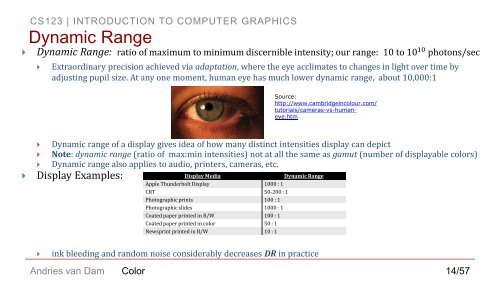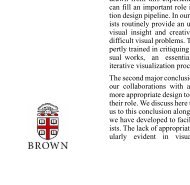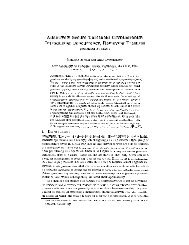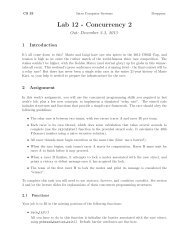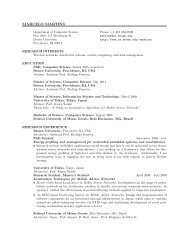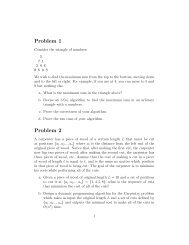Introduction to Color - Brown University
Introduction to Color - Brown University
Introduction to Color - Brown University
Create successful ePaper yourself
Turn your PDF publications into a flip-book with our unique Google optimized e-Paper software.
CS123 | INTRODUCTION TO COMPUTER GRAPHICS<br />
Dynamic Range<br />
Dynamic Range: ratio of maximum <strong>to</strong> minimum discernible intensity; our range: 10 <strong>to</strong> 10 10 pho<strong>to</strong>ns/sec<br />
<br />
Extraordinary precision achieved via adaptation, where the eye acclimates <strong>to</strong> changes in light over time by<br />
adjusting pupil size. At any one moment, human eye has much lower dynamic range, about 10,000:1<br />
Source:<br />
http://www.cambridgeincolour.com/<br />
tu<strong>to</strong>rials/cameras-vs-humaneye.htm<br />
<br />
<br />
<br />
<br />
Dynamic range of a display gives idea of how many distinct intensities display can depict<br />
Note: dynamic range (ratio of max:min intensities) not at all the same as gamut (number of displayable colors)<br />
Dynamic range also applies <strong>to</strong> audio, printers, cameras, etc.<br />
Display Examples:<br />
Display Media<br />
Dynamic Range<br />
Apple Thunderbolt Display 1000 : 1<br />
CRT 50-200 : 1<br />
Pho<strong>to</strong>graphic prints 100 : 1<br />
Pho<strong>to</strong>graphic slides 1000 : 1<br />
Coated paper printed in B/W 100 : 1<br />
Coated paper printed in color 50 : 1<br />
Newsprint printed in B/W 10 : 1<br />
<br />
ink bleeding and random noise considerably decreases DR in practice<br />
Andries van Dam <strong>Color</strong> 14/57


